-
 Bitcoin
Bitcoin $107,725.9156
0.27% -
 Ethereum
Ethereum $2,481.6786
1.84% -
 Tether USDt
Tether USDt $1.0003
0.01% -
 XRP
XRP $2.2154
1.26% -
 BNB
BNB $658.2447
1.42% -
 Solana
Solana $157.2028
4.24% -
 USDC
USDC $1.0000
0.02% -
 TRON
TRON $0.2788
0.91% -
 Dogecoin
Dogecoin $0.1655
1.00% -
 Cardano
Cardano $0.5714
2.67% -
 Hyperliquid
Hyperliquid $40.6187
6.30% -
 Bitcoin Cash
Bitcoin Cash $519.8117
5.84% -
 Sui
Sui $2.8338
0.59% -
 Chainlink
Chainlink $13.4150
0.60% -
 UNUS SED LEO
UNUS SED LEO $9.1205
-0.54% -
 Avalanche
Avalanche $18.0666
0.85% -
 Stellar
Stellar $0.2363
-0.46% -
 Toncoin
Toncoin $2.9550
2.57% -
 Shiba Inu
Shiba Inu $0.0...01151
-0.15% -
 Litecoin
Litecoin $86.2252
-0.57% -
 Hedera
Hedera $0.1498
1.51% -
 Monero
Monero $318.0620
3.18% -
 Polkadot
Polkadot $3.4174
-0.02% -
 Dai
Dai $1.0000
0.02% -
 Bitget Token
Bitget Token $4.5444
-1.05% -
 Ethena USDe
Ethena USDe $1.0003
0.00% -
 Uniswap
Uniswap $7.1773
-0.53% -
 Pepe
Pepe $0.0...09916
3.19% -
 Aave
Aave $274.7399
0.32% -
 Pi
Pi $0.5136
-2.06%
Is the continuous small positive line accumulation at a low level the main force to build a position?
Continuous small positive line accumulation in crypto suggests gradual buying pressure, often signaling potential bullish momentum when confirmed by volume and technical indicators.
Jun 30, 2025 at 08:15 pm
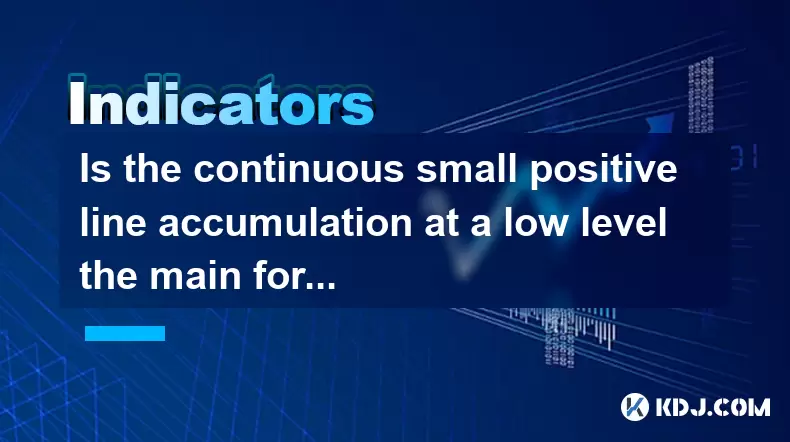
Understanding the Concept of Continuous Small Positive Line Accumulation
In cryptocurrency trading, continuous small positive line accumulation refers to a pattern where an asset experiences multiple consecutive candlesticks or bars that close higher than they open, but with relatively low volume and minimal price movement. This phenomenon is often observed during periods of consolidation or sideways market movement.
Traders interpret this behavior differently depending on their strategies and timeframes. Some view it as a sign of slow but deliberate buying pressure, while others may dismiss it as noise in the market. The key question here is whether such a pattern indicates genuine accumulation by large players or simply random market activity.
Continuous small positive line accumulation can be visualized through candlestick charts, where each green (or bullish) candlestick shows a slight upward close without significant volatility.
Identifying Accumulation Patterns in Cryptocurrency Markets
To determine whether small positive lines are indicative of accumulation, traders often combine technical analysis tools such as volume indicators, moving averages, and order book depth. Here's how you can identify accumulation patterns:
- Volume Analysis: Look for increasing volume during small positive closes. If volume remains consistent or rises slightly, it may suggest institutional or whale buying.
- Price Action Context: Check if these small positive moves occur near strong support levels or after extended downtrends. These could signal strategic entry points.
- Order Book Depth: Analyze bid-ask spreads and liquidity concentrations. Deep buy walls at certain price levels can indicate hidden accumulation.
Accumulation patterns typically form over several days or weeks and should not be confused with short-term bullish spikes driven by news or hype.
The Role of Institutional Investors in Position Building
One reason why continuous small positive line accumulation might be considered a main force in building positions lies in how large investors operate. Institutions or whales cannot enter or exit large positions without significantly affecting the market price. To avoid detection, they often use slow and steady accumulation techniques.
These entities place orders gradually over time, sometimes using algorithms to break up large trades into smaller ones. This method helps them avoid triggering sudden price surges or drawing attention from retail traders.
Institutional accumulation can lead to prolonged periods of sideways movement punctuated by small positive closes, especially in lower-cap altcoins or newer tokens with thinner order books.
How Retail Traders Can Interpret These Patterns
Retail traders who notice a series of small positive candles may wonder if they should follow suit. However, interpreting these patterns requires caution and context. Here’s how retail traders can approach such situations:
- Compare With Broader Market Trends: Ensure that the accumulation pattern isn’t just part of a general uptrend across the entire market.
- Use On-Balance Volume (OBV): OBV can help confirm whether buying pressure is indeed increasing despite modest price gains.
- Look for Breakouts: Once accumulation ends, a breakout above resistance levels often follows. Waiting for confirmation before entering can reduce false signals.
Retail traders must differentiate between real accumulation and normal market fluctuations by combining candlestick patterns with other confirming indicators.
Technical Indicators That Support Accumulation Analysis
Several technical indicators can complement the visual observation of accumulation patterns:
- Moving Averages: Use 50-day and 200-day moving averages to assess long-term trends. A rising MA slope combined with small positive closes suggests gradual strength.
- Relative Strength Index (RSI): RSI values hovering around 50 or slightly above can indicate neutral-to-bullish sentiment without overbought conditions.
- Chaikin Money Flow (CMF): CMF values above zero confirm buying pressure, aligning with the idea of accumulation.
Using multiple indicators together increases the probability of accurately identifying true accumulation zones rather than random price movements.
Frequently Asked Questions
Q: What timeframes are most suitable for observing accumulation patterns?
A: Accumulation patterns are best viewed on daily or weekly charts. Shorter timeframes like hourly or 4-hour intervals tend to show too much noise, making it harder to distinguish real accumulation from normal volatility.
Q: Can accumulation patterns fail or give false signals?
A: Yes, accumulation patterns can mislead traders if not confirmed by volume or other indicators. Sometimes what appears to be accumulation is merely range-bound price action with no directional intent.
Q: How long does a typical accumulation phase last in crypto markets?
A: It varies based on market conditions and asset type. In highly volatile cryptocurrencies, accumulation phases may last anywhere from a few days to several months. Altcoins often take longer to accumulate compared to major coins like Bitcoin or Ethereum.
Q: Is there a way to automate the detection of accumulation patterns?
A: Yes, traders can use algorithmic tools or custom scripts on platforms like TradingView to scan for specific candlestick patterns combined with volume thresholds. However, manual review is still recommended to filter out false positives.
Disclaimer:info@kdj.com
The information provided is not trading advice. kdj.com does not assume any responsibility for any investments made based on the information provided in this article. Cryptocurrencies are highly volatile and it is highly recommended that you invest with caution after thorough research!
If you believe that the content used on this website infringes your copyright, please contact us immediately (info@kdj.com) and we will delete it promptly.
- Coinbase, Altcoins, and Listings: What's the Buzz?
- 2025-07-01 00:30:11
- Chainlink's Bullish Signals: Investors Bet on Long-Term Value
- 2025-07-01 00:50:12
- Bybit, Kraken, and Tokenized Stocks: A New Era for Trading?
- 2025-07-01 00:30:11
- MicroStrategy, S&P 500, and Crypto News: A Wild Ride for Bitcoin and Beyond
- 2025-07-01 00:55:11
- Week Review: Neo Updates, Crypto Market Movers, and the Stablecoin Evolution (June 23-29)
- 2025-07-01 01:00:12
- Crypto.com & dYdX: Derivative Trading Revolutionized for Everyone
- 2025-07-01 00:35:12
Related knowledge
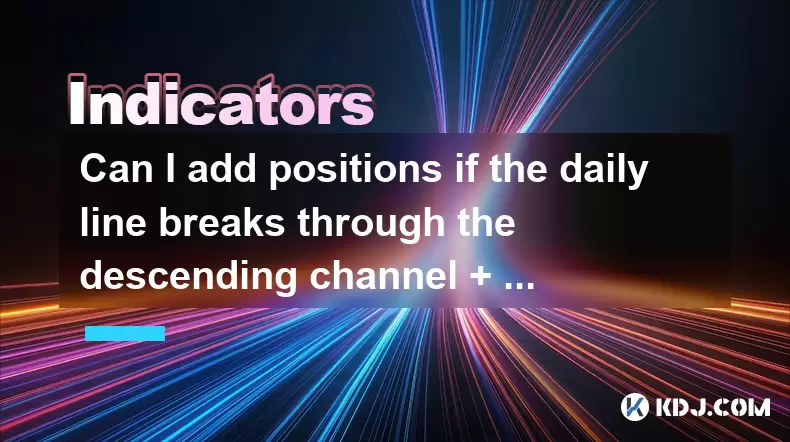
Can I add positions if the daily line breaks through the descending channel + the 30-minute moving average is in a bullish arrangement?
Jun 30,2025 at 11:00pm
Understanding the Descending Channel BreakoutWhen a daily line breaks through a descending channel, it indicates a potential shift in market sentiment from bearish to bullish. A descending channel is formed by drawing two parallel trendlines, where the upper trendline connects the lower highs and the lower trendline connects the lower lows. A breakout o...
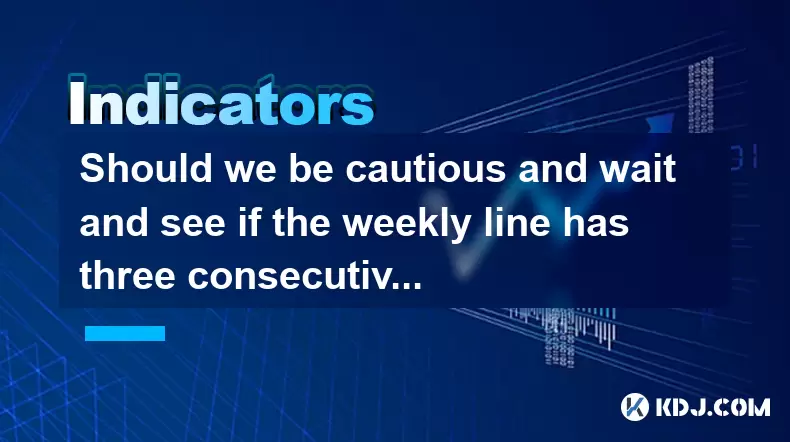
Should we be cautious and wait and see if the weekly line has three consecutive Yin lines + the daily MACD green column enlarges?
Jul 01,2025 at 12:42am
Understanding the Weekly Three Consecutive Yin Lines PatternIn technical analysis, three consecutive Yin lines on a weekly chart indicate a strong bearish trend. Each Yin line represents a week where the closing price is lower than the opening price, signaling consistent selling pressure. When this pattern appears three times in succession, it often sug...
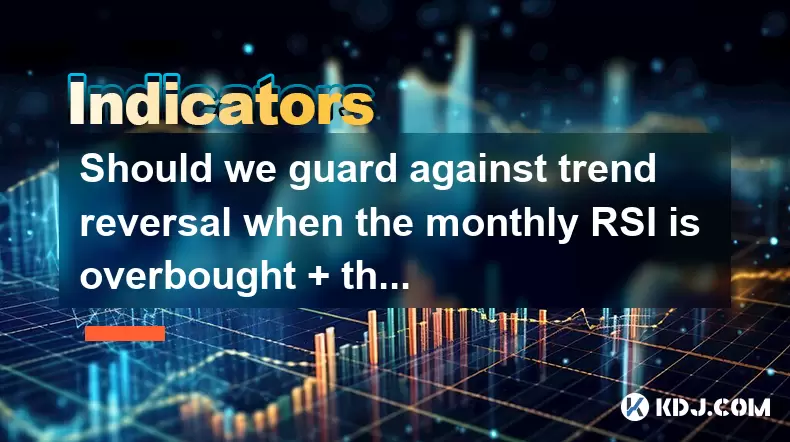
Should we guard against trend reversal when the monthly RSI is overbought + the weekly line has a long upper shadow?
Jun 30,2025 at 11:35pm
Understanding RSI Overbought Conditions in CryptocurrencyThe Relative Strength Index (RSI) is a momentum oscillator commonly used in technical analysis to identify overbought or oversold conditions in an asset. When the monthly RSI of a cryptocurrency reaches above 70, it is generally considered overbought, suggesting that the asset may be due for a pul...
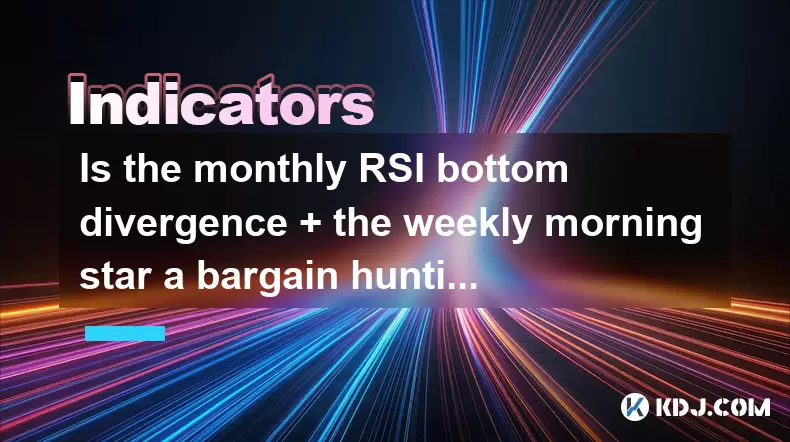
Is the monthly RSI bottom divergence + the weekly morning star a bargain hunting opportunity?
Jun 30,2025 at 09:57pm
Understanding RSI Bottom Divergence in Monthly TimeframesThe Relative Strength Index (RSI) is a momentum oscillator commonly used to identify overbought or oversold conditions in the market. When traders refer to a monthly RSI bottom divergence, they're observing a situation where the price makes a lower low, but the RSI makes a higher low on the monthl...
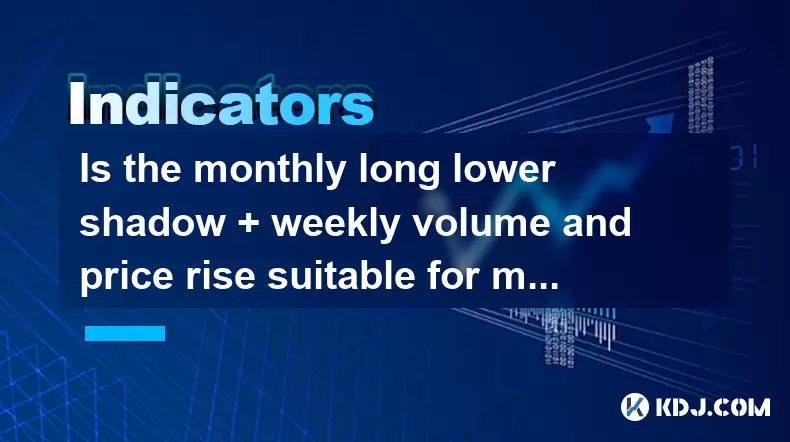
Is the monthly long lower shadow + weekly volume and price rise suitable for mid-term layout?
Jul 01,2025 at 01:29am
Understanding the Monthly Long Lower Shadow PatternA monthly long lower shadow candlestick pattern occurs when the price of a cryptocurrency drops significantly during the month but then rebounds to close near or above the opening price. This creates a candle with a long wick below and a relatively small body. In technical analysis, this pattern is ofte...
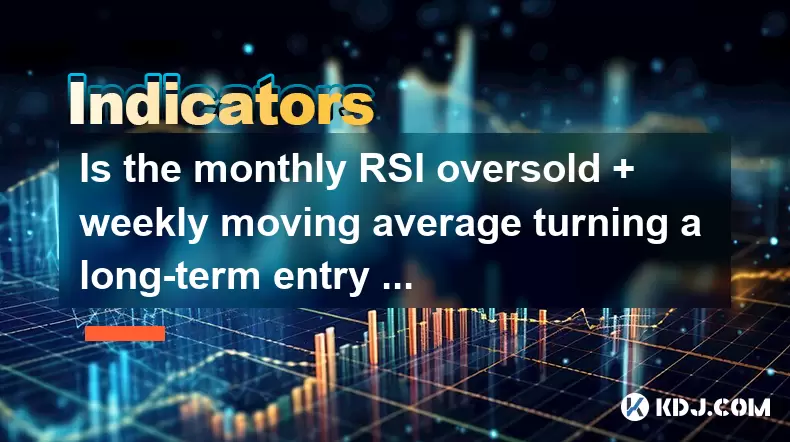
Is the monthly RSI oversold + weekly moving average turning a long-term entry signal?
Jun 30,2025 at 11:42pm
Understanding RSI and Its Role in Cryptocurrency TradingThe Relative Strength Index (RSI) is a momentum oscillator commonly used by traders to identify overbought or oversold conditions in the market. In the context of cryptocurrency, where volatility reigns supreme, understanding how RSI behaves on different timeframes becomes crucial. When the monthly...

Can I add positions if the daily line breaks through the descending channel + the 30-minute moving average is in a bullish arrangement?
Jun 30,2025 at 11:00pm
Understanding the Descending Channel BreakoutWhen a daily line breaks through a descending channel, it indicates a potential shift in market sentiment from bearish to bullish. A descending channel is formed by drawing two parallel trendlines, where the upper trendline connects the lower highs and the lower trendline connects the lower lows. A breakout o...

Should we be cautious and wait and see if the weekly line has three consecutive Yin lines + the daily MACD green column enlarges?
Jul 01,2025 at 12:42am
Understanding the Weekly Three Consecutive Yin Lines PatternIn technical analysis, three consecutive Yin lines on a weekly chart indicate a strong bearish trend. Each Yin line represents a week where the closing price is lower than the opening price, signaling consistent selling pressure. When this pattern appears three times in succession, it often sug...

Should we guard against trend reversal when the monthly RSI is overbought + the weekly line has a long upper shadow?
Jun 30,2025 at 11:35pm
Understanding RSI Overbought Conditions in CryptocurrencyThe Relative Strength Index (RSI) is a momentum oscillator commonly used in technical analysis to identify overbought or oversold conditions in an asset. When the monthly RSI of a cryptocurrency reaches above 70, it is generally considered overbought, suggesting that the asset may be due for a pul...

Is the monthly RSI bottom divergence + the weekly morning star a bargain hunting opportunity?
Jun 30,2025 at 09:57pm
Understanding RSI Bottom Divergence in Monthly TimeframesThe Relative Strength Index (RSI) is a momentum oscillator commonly used to identify overbought or oversold conditions in the market. When traders refer to a monthly RSI bottom divergence, they're observing a situation where the price makes a lower low, but the RSI makes a higher low on the monthl...

Is the monthly long lower shadow + weekly volume and price rise suitable for mid-term layout?
Jul 01,2025 at 01:29am
Understanding the Monthly Long Lower Shadow PatternA monthly long lower shadow candlestick pattern occurs when the price of a cryptocurrency drops significantly during the month but then rebounds to close near or above the opening price. This creates a candle with a long wick below and a relatively small body. In technical analysis, this pattern is ofte...

Is the monthly RSI oversold + weekly moving average turning a long-term entry signal?
Jun 30,2025 at 11:42pm
Understanding RSI and Its Role in Cryptocurrency TradingThe Relative Strength Index (RSI) is a momentum oscillator commonly used by traders to identify overbought or oversold conditions in the market. In the context of cryptocurrency, where volatility reigns supreme, understanding how RSI behaves on different timeframes becomes crucial. When the monthly...
See all articles

























































































